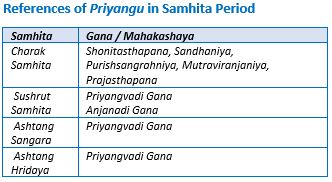An evaluation of pharmacological actions of Padmak Agada: A Review
DOI:
https://doi.org/10.21760/jaims.8.3.17Keywords:
Keet Visha, insect bite, Pharmacological actions, Agada, Padmakagada.Abstract
Agada means the medicaments which have antitoxic properties. They are used to combat Gada which means disease, discomforts, pain, or morbid conditions produced by any type of the poison. For the management of different poisons many formulations are mentioned in Ayurveda. Acharaya Vagbhatta has mentioned so many formulations in Keetlootadivishpratishedham Adhyay of Ashtanghrudayam Uttarsthana. One of those formulation is Padmakagada, which is indicated in the treatment of all types of insect bite (Keet Visha and Loota Visha). Padmakagada can be used in different forms like Nasya (Nasal instillation), Dhoom (medicated smoke), Abhyanga (massage), Paan (drink) etc. It contains 5 ingredients including Priyangu, Haridra, Daruharidra, ghee and honey. Easy availability of its ingredients and simplicity of the preparation and preservation of the formulation may encourage the physician to use this formulation. Here is an effort has been made to review Padmak Agada in order to its pharmacological properties for its medicinal use.
Downloads
References
http://ayurveda.iloveindia.com/ayurvedictreatment/agad-tantra.html.
Ashtang Haridyam Tripathi Brahmanand, Chaukhambha Sanskrit Pratishthna, Delhi, 2012.
Charak Samhita Vidyotini Hindi Vyakhya, Sri Satya Narayan Shastri, edition 2015, Choukhambha Bharti Academy.
Sushrut Samhita Vimarshini Hindi Vyakhya, Ananta Ram Sharma , edition 2012, Choukhambha Bharti Academy
Ashtang Haridyam Tripathi Brahmanand, Chaukhambha Sanskrit Pratishthna, Delhi, 2012.
Ashtang Haridyam Tripathi Brahmanand, Chaukhambha Sanskrit Pratishthna, Delhi, 2012.
Priyavrat Sharma – Dravyaguna Vidnyana, part-2, Edition reprint -2015, published by Chaukhambha Bharati Academy Varanasi
Khare CP, Indian medicinal plants, reprint 2008, Springer publication, New York
Verma RK, Singh AK, Srivastava P, Shanker K, Kalra A and Gupta MM: Determination of novel plant growth promoting diterpenes in Callicarpa macrophylla by HPLC and HPTLC. J Liq Chroma Rela Techno. 2009; 32(16): 2437-2450.
Anonymous. (2008). The Ayurvedic Pharmacopoeia of India, New Delhi: Department of Ayurveda, Yoga & Naturopathy, Unani, Siddha and Homoeopathy, Ministry of Health and Family Welfare, Government of India. Part-I, Vol. 4, pp. 111–112.
Acharya Priyavrat Sharma, Dravya Guna Vidnyana, 16th ed. Chaukhamba Bharati Academy, Varanasi
Ganesh Garde. Sarth Vagbhat. Pune: Gajanan Book Depot, 7th edition, 1983. Sutrasthana 15/7.
Chunekar K, Pandeya G, [ed.]. Bhavprakash Nighantu. Varanasi: Chaukhamba Bharti Academy, reprint, 2006. p 248 shloka 102-103.
Ozha J, Mishr U, [ed.]. Dhanvantari Nighantu. Delhi: Chaukhamba Sanskrit Pratishthana, 2004. p 125 shloka 16.
Virendera Yadava Soma Jayalakshmia & others Indo-Global Journal of Pharmaceutical Sciences, 2011; 1: 3
Santosh Kumar Gupta & Others, International Research Journal of Pharmacy, 2013; 4:3.
Yadav V, Jayalakshmi S, Patra A and Singla RK: Investigation of analgesic & anti-pyretic potentials of Callicarpa macrophylla Vahl leaves extracts. Webmed Central: International Journal Med Mole Med 2012; 3(6): WMC003447.
Yadav V, Jayalakshmi S, Singla RK and Patra A: Ex vivo screening of stem extracts of Callicarpa macrophylla Vahl for antifungal activity. Indo Global J Pharma Sci 2012; 2(2): 103-107.
Gupta SK, Gupta A, Gupta AK, Prakash D and Vedpal: Invitro anti-arthritic activity of ethanolic extract of Callicarpa macrophylla flower. Int Res J Pharm 2013; 4(3): 160-162.
Patel, S. R. (2011). Evaluation of alcoholic extract of Callicarpa macrophylla flowers for its anti-diabetic activity (Unpublished M.Pharm thesis). Rajiv Gandhi University of Health Sciences Bangalore, Karnataka.
Charak Samhita with commentary of chakrapanidatta, edited by vaidhya acharya Yadavji Tikramji 5th edition, Varanasi, Chaukhamba Sanskrit Sansthan 2001
Kaviraj dr. Ambikadutta Shastri, Sushrut Samhita, part 1, edition 2012 and part 2 utter tantra, edition 2013, Chaukhamba Sanskrit Sansthan, Varanasi
Brahamanand Tripathi, Ashtang Hridyam, pub-Chaukhamba Sanskrit pratishthan, Reprint 2015, Delhi 110007
Paranjpe P (2001) Herbs for Beauty. (1stedn), Chaukhambha Sanskrit Pratishthan, Delhi, India 95-96.
Sastry JLN (2005) Illustrated Dravyaguna Vijnana. (2ndedn), Chaukhambha Orientalia, Varanasi, India 513-518.
Sharma PV (2006) DravyaGuna Vijnana, Chaukhambha Bharti Academy, Varanasi, India 1: 162-166.
Chunekar KC (2010) Editor Bhavpraakash Nighantu of BhavaMisra. Chaukhambha Bharti Academy, Varanasi: 110.
Pandey GS (2002) Dravyaguna Vijnana (2ndedn), Krishnadas Academy, Varanasi, India 1: 737-746.
API, Part -1, Volume 2 Page 55-58
A Review on pharmacological potential of Berberin, An active component of Himalayan Berberis aristata. J phytopharmacol 2017;6(1):53-5
Anti- inflammatory, Antiparasitic action-Asian Journal of Biomedical and Pharmacutical science ISSN 2249-6222X.
Mazumder papaya mitra, Phyto- pharmacology Of Berberis Aristata DC: A Review Journal of drug delivery & therapeutics; 2011,1(2):45-60.















